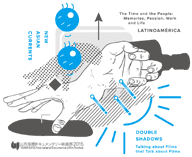New Asian Currents
|
|
New Asian Currents Special Invitation Films
|
- Jurors
- Kawakami Koichi • The Blossoming of Etsuko Kamiya
Gargi Sen • A School of My Own | Beyond Monarchs and Merchants
Into the Great Expanse of Film
When you row out into the vast ocean of Asia, so deep and wide that its sweep seems limitless, there is some interval—between the realization that there are others floating about in the same way as you are, and the moment when you can make contact with them—during which you find yourself stalked by a rather extraordinary anxiety: “am I the only one out here?” Surely I’ll meet someone, you keep saying to yourself, but in the meantime all there is to do is sink to the bottom, rise back to the top, float for a while, and keep on swimming. This is the feeling that I get once every two years when I watch, film by film, our entries from around the world.
Preparation for the festival begins with watching the entries. The process of getting to know the films and the new worlds that emerge before me from this great ocean is like going to film school. I peer out at film’s tsukurite (the filmmakers—literally the “hands that make” the films), tossed back and forth amidst the waves, and strain my ears to catch the voices of films calling from the ocean floor. I become invested in the journey that film each has taken, from the planting of the seed to its emergence and future. Seized by a despair that threatens to drown me, and a loneliness that scuttles me into the depths, I cast about for ways to grasp the commotion that these films have created and confronted me with.
The gaze of the tsukurite—fixed upon the film’s subject—is the tsukurite’s mirrored self, trying to engage with the film’s subjects, and through each film I desperately try to follow this gaze. Soon the film, its tsukurite, the people the film depicts, and the world itself, begin to soar across borders, to venture out through space and time, inviting me to places beyond what my imagination could ever have conceived. Before long, I might find myself in the great ocean once more, bobbing along pleasantly. I want to see the world that is yet to come, prompted by the birth of a film, and I often wonder if the films’ tsukurite might be working with this same thought in mind.
 For each festival we ask an artist from Asia to design a t-shirt, and this year it bears the image of a tsukurite’s hands. Indonesian artists Ellena Ekarahendy and Gery Paulandhika explained that they chose the image of hands to represent the intimate proximity between tsukurite and the works that an independent filmmaker creates. The hands embody the spirit that constantly challenges the current framework of films, breaks it apart, and endeavors to create new forms of expression.
For each festival we ask an artist from Asia to design a t-shirt, and this year it bears the image of a tsukurite’s hands. Indonesian artists Ellena Ekarahendy and Gery Paulandhika explained that they chose the image of hands to represent the intimate proximity between tsukurite and the works that an independent filmmaker creates. The hands embody the spirit that constantly challenges the current framework of films, breaks it apart, and endeavors to create new forms of expression.
It is the hands that make the film, scoop up the world and pass it on. They might be hands clenched in fists of anger, hands raised against power, hands clapping with joy, hands that weave words, hands that embrace, hands that wave away the past, hands that grasp at clouds, hands that cradle the head, hands that compose a letter, hands that wipe away tears, hands that crank the camera, hands that reach timidly or boldly, for something beyond reach . . . When these hands split apart and reclaim the land of film as if plowing through soil, what will grow there? The films, their tsukurite, the audience members, and the great many people who participate in the process of holding a film festival create a space for film that flows into connecting streams of encounters—these become the cascading of tens of thousands of “Asian currents.” And these waves themselves join the great, limitless ocean of spaces for film.
If there were no films, there would be no festival. Without the festival, there would be none of the encounters between people and films that it brings. This space for film, endowed with infinite potential, would remain unrealized. Once again this year, with the help of so many hands, the New Asian Currents program sets sail. For this I would like to extend my deepest gratitude.
